
Czechoslovakia was a landlocked state in Central Europe, created in 1918, when it declared its independence from Austria-Hungary. In 1938, after the Munich Agreement, the Sudetenland became part of Nazi Germany, while the country lost further territories to Hungary and Poland. Between 1939 and 1945, the state ceased to exist, as Slovakia proclaimed its independence and Carpathian Ruthenia became part of Hungary, while the German Protectorate of Bohemia and Moravia was proclaimed in the remainder of the Czech Lands. In 1939, after the outbreak of World War II, former Czechoslovak President Edvard Beneš formed a government-in-exile and sought recognition from the Allies.

Klement Gottwald was a Czech communist politician, who was the leader of the Communist Party of Czechoslovakia from 1929 until his death in 1953 – titled as general secretary until 1945 and as chairman from 1945 to 1953. He was the first leader of Communist Czechoslovakia from 1948 to 1953.

The military occupation of Czechoslovakia by Nazi Germany began with the German annexation of the Sudetenland in 1938, continued with the creation of the Protectorate of Bohemia and Moravia, and by the end of 1944 extended to all parts of Czechoslovakia.

The Third Czechoslovak Republic, officially the Czechoslovak Republic, was a sovereign state from April 1945 to February 1948 following the end of World War II.
With the collapse of the Habsburg monarchy at the end of World War I, the independent country of Czechoslovakia was formed as a result of the critical intervention of U.S. President Woodrow Wilson, among others.
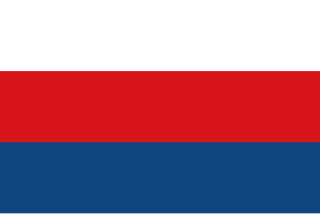
The Protectorate of Bohemia and Moravia was a partially-annexed territory of Nazi Germany that was established on 16 March 1939 after the German occupation of the Czech lands. The protectorate's population was mostly ethnic Czech.

Reinhard Heydrich, the commander of the German Reich Security Main Office (RSHA), the acting governor of the Protectorate of Bohemia and Moravia and a principal architect of the Holocaust, was assassinated during the Second World War in a coordinated operation by the Czechoslovak resistance. The assassination attempt, code-named Operation Anthropoid, was carried out by resistance operatives Jozef Gabčík and Jan Kubiš on 27 May 1942. Heydrich was wounded in the attack and died of his injuries on 4 June.

Ludvík Svoboda was a Czech general and politician. He fought in both World Wars, for which he was regarded as a national hero, and he later served as the president of Czechoslovakia from 1968 to 1975.

Karl Hermann Frank was a Sudeten German Nazi official in the Protectorate of Bohemia and Moravia prior to and during World War II. Attaining the rank of Obergruppenführer, he was in command of the Nazi police apparatus in the protectorate, including the Gestapo, the SD, and the Kripo. After the war, he was tried, convicted and executed by hanging for his role in organizing the massacres of the people of the Czech villages of Lidice and Ležáky.
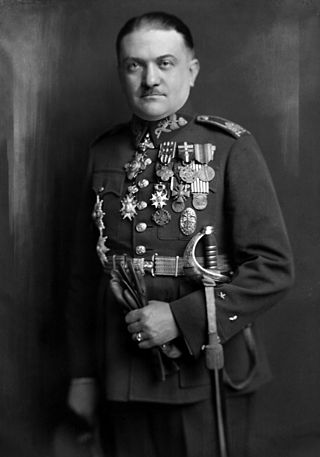
Alois Eliáš was a Czech general and politician. He served as prime minister of the puppet government of the German-occupied Protectorate of Bohemia and Moravia from 27 April 1939 to 27 September 1941 but maintained contact with the government-in-exile. Because of his participation in the anti-Nazi resistance, he was the only head of government who was murdered by the Nazis during World War II.
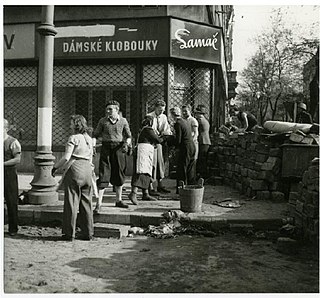
The Prague uprising was a partially successful attempt by the Czech resistance movement to liberate the city of Prague from German occupation in May 1945, during the end of World War II. The preceding six years of occupation had fuelled anti-German sentiment and the rapid advance of Allied forces from the Red Army and the United States Army offered the resistance a chance of success.

Richard Bienert was a Czech high-ranking police officer and politician. He served as prime minister of the Protectorate of Bohemia and Moravia from January 19 to May 5, 1945. After World War II he was sentenced to prison for collaboration with Nazis.

Emanuel Moravec was a Czech army officer and writer who served as the collaborationist Minister of Education of the Protectorate of Bohemia and Moravia between 1942 and 1945. He was also chair of the Board of Trustees for the Education of Youth, a fascist youth organisation in the protectorate.

These are lists of political office-holders in the Protectorate of Bohemia and Moravia, which from 15 March 1939 until 9 May 1945 comprised the German-occupied parts of Czechoslovakia. The lists include both the representatives of the recognized Czech authorities as well as the German Reichsprotektoren and the Staatsminister, who held the real executive power.

Ležáky, in the Miřetice municipality, was a village in Czechoslovakia. During the German occupation of Czechoslovakia, it was razed by Nazi forces as reprisal for Reich Protector Reinhard Heydrich's assassination in late spring 1942.

The Czechoslovak government-in-exile, sometimes styled officially as the Provisional Government of Czechoslovakia, was an informal title conferred upon the Czechoslovak National Liberation Committee, initially by British diplomatic recognition. The name came to be used by other Allied governments during the Second World War as they subsequently recognised it. The committee was originally created by the former Czechoslovak President, Edvard Beneš in Paris, France, in October 1939. Unsuccessful negotiations with France for diplomatic status, as well as the impending Nazi occupation of France, forced the committee to withdraw to London in 1940. The Czechoslovak Government-in-Exile offices were at various locations in London but mainly at a building called Fursecroft, Marylebone.

Edvard Beneš was a Czech politician and statesman who served as the president of Czechoslovakia from 1935 to 1938, and again from 1939 to 1948. During the first six years of his second stint, he led the Czechoslovak government-in-exile during World War II.
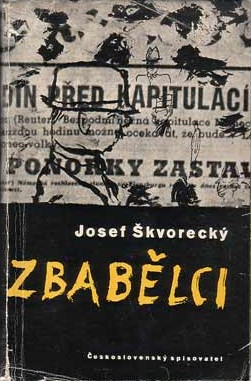
The Cowards is a Czech novel by Josef Škvorecký. Written in 1948–49 but not published until 1958, it is a story from the very end of the Second World War in Europe. Narrated in the first person by a Czech at the end of his teens, Danny Smiřický, it takes place in the week 4–11 May 1945 in his home town, a fictional town called Kostelec in northeast Bohemia, close to the frontier with then-German Middle Silesia.

The 1st Czechoslovak Partisan Brigade of Jan Žižka, initially known as Ušiak-Murzin Unit, was the largest partisan unit in the Protectorate of Bohemia and Moravia during the German occupation of Czechoslovakia. After its core membership of Soviet-trained paratroopers were dropped into Slovakia in August 1944, the brigade crossed into Moravia and began operations in earnest at the end of 1944. Its focus was guerrilla warfare, especially sabotage and intelligence gathering.

The Holocaust in Bohemia and Moravia resulted in the deportation, dispossession, and murder of most of the pre-World War II population of Jews in the Czech lands that were annexed by Nazi Germany between 1939 and 1945.
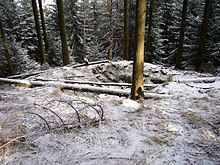
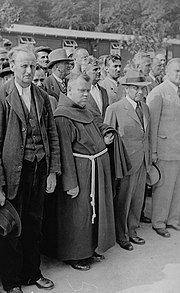

![A plaque on the corner of Petschek Palace commemorates the victims of the Heydrichiada [cs]. Czech resistance memorial.jpg](http://upload.wikimedia.org/wikipedia/commons/thumb/d/d9/Czech_resistance_memorial.jpg/200px-Czech_resistance_memorial.jpg)















